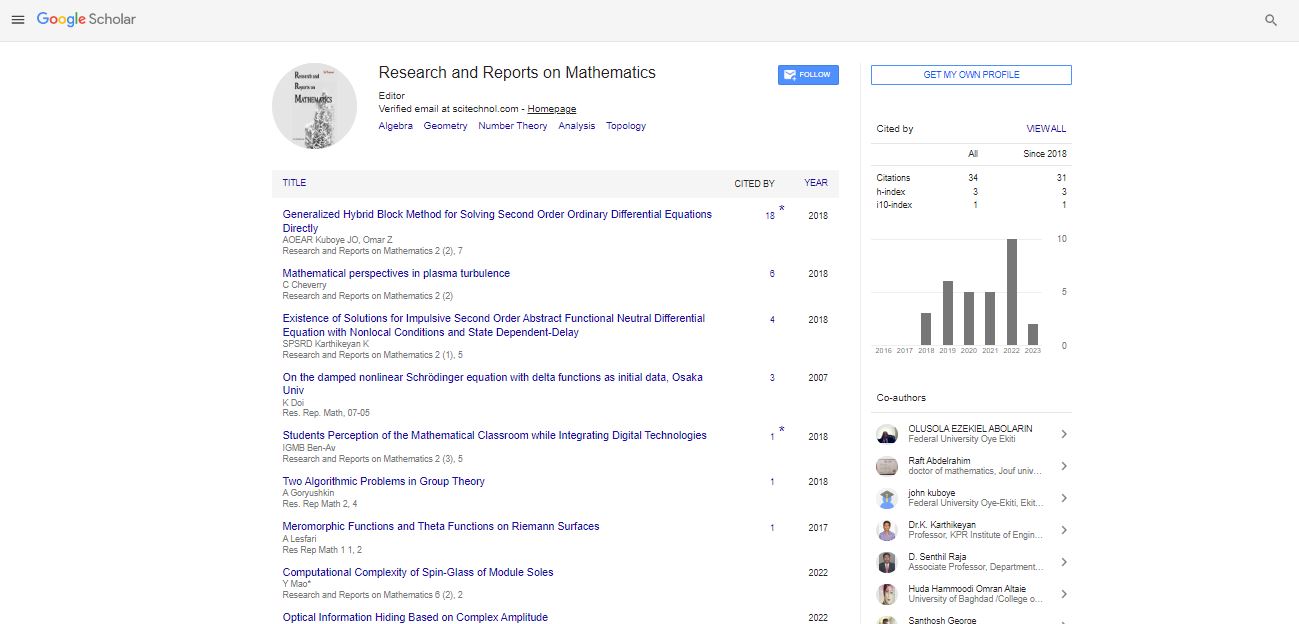Opinion Article, Res Rep Math Vol: 7 Issue: 5
Topological Data Analysis: Algebraic Structures for Insightful Data Interpretation
Whitney Akagi*
1Department of Mathematical Sciences, Yeshiva University, United States of America
*Corresponding Author: Whitney Akagi,
Department of Mathematical Sciences,
Yeshiva University, United States of America
E-mail: akagi@yu.edu
Received date: 27 November, 2023, Manuscript No. RRM-24-124961;
Editor assigned date: 29 November, 2023, Pre QC No. RRM-24-124961 (PQ);
Reviewed date: 14 December, 2023, QC No.RRM-24-124961;
Revised date: 21 December, 2023, Manuscript No.RRM-24-124961 (R);
Published date: 28 December, 2023, DOI: 07.4172/rrm.1000219
Citation: Akagi W (2023) Topological Data Analysis: Algebraic Structures for Insightful Data Interpretation. Res Rep Math 7:5.
Description
Topology, a branch of mathematics born out of the desire to understand spatial relationships and continuity, has evolved into a profound and diverse field with applications ranging from abstract mathematics to real-world problem-solving. At its core, topology is concerned with the study of properties preserved under continuous deformations, encompassing concepts such as continuity, compactness, and connectivity. The origins of topology can be traced back to the 18th century, with the works of Euler, who introduced the concept of Eulerian paths and bridges. However, the formalization of topology as a distinct mathematical discipline began in the early 20th century, driven by the groundbreaking contributions of mathematicians like Henri Poincaré and Georg Cantor. Poincaré's work on homology theory and the fundamental group laid the groundwork for modern algebraic topology, marking a pivotal moment in the development of this field. Topology explores the properties of spaces that remain invariant under continuous transformations, emphasizing the importance of nearness and closeness without the constraints of distance measurements. The fundamental concepts of topology include open sets, continuity, compactness, and connectedness. Open sets provide a flexible framework for defining neighborhoods and continuity, allowing mathematicians to capture the essence of spatial relationships without relying on specific metrics.
A central notion in topology is that of a topological space, which generalizes the concept of metric spaces. Topological spaces allow mathematicians to study the intrinsic properties of spaces that are preserved under homeomorphisms continuous and bijective mappings with continuous inverses. This abstraction enables the examination of shapes and structures at a more fundamental level, irrespective of the particular metric used to measure distances. Homeomorphisms play a crucial role in topology, serving as a means to identify spaces that, despite different appearances, share the same topological properties. Spaces that are homeomorphic are considered equivalent in the realm of topology.
This notion of equivalence under continuous transformations allows mathematicians to study the essential features of different spaces without being overly concerned with specific geometric details. Algebraic topology explores the connections between topology and algebra, providing powerful tools to analyze and classify topological spaces. Fundamental groups, homology, and cohomology are algebraic invariants that capture essential features of topological spaces and distinguish between different shapes. The interplay between topology and algebraic structures enriches our understanding of spatial relationships and facilitates the classification of topological spaces. Manifolds, a central concept in topology, are spaces that resemble Euclidean spaces on a local scale. They provide a bridge between topology and geometry, serving as a foundation for understanding curved spaces and surfaces. Manifold theory plays a vital role in differential geometry and the study of spaces with intrinsic curvature, such as those encountered in general relativity.
Applications
Topology finds wide-ranging applications in geometry and physics. The classification of surfaces, a fundamental problem in topology, has implications in geometry, leading to insights into the nature of surfaces that can be smoothly deformed into one another. In physics, topology plays a role in the study of phase transitions, quantum states, and the properties of materials with nontrivial topological characteristics. Knot theory, a specialized branch of topology, focuses on the study of mathematical knots closed curves embedded in three-dimensional space. The classification and analysis of knots involve topological concepts such as isotopy and invariants like the Alexander polynomial. Knot theory has applications in chemistry, physics, and biology, providing a framework to understand the structure and behavior of intertwined structures. In recent years, topology has found innovative applications in data analysis through the emerging field of Topological Data Analysis (TDA). TDA leverages algebraic topology to extract meaningful insights from complex datasets, revealing hidden structures and relationships that may not be apparent through traditional statistical methods. TDA has proven valuable in fields such as neuroscience, biology, and machine learning.
Topological robotics explores the application of topological concepts to the field of robotics. By considering the connectivity and configuration spaces of robotic systems, mathematicians and engineers can design algorithms that guarantee certain properties, such as collision avoidance or continuous motion planning. Topological robotics provides a robust and abstract framework for addressing challenges in the control and navigation of robotic systems. While topology has made remarkable strides in diverse applications, challenges remain. The development of computational tools for handling large-scale topological data, further integration with machine learning techniques, and the exploration of topological concepts in quantum computing are areas ripe for exploration. As topology continues to evolve, its interdisciplinary nature promises new insights into complex systems and structures.
Conclusion
In conclusion, topology stands as a vibrant and evolving branch of mathematics that transcends traditional geometric and metric constraints. From its historical roots to its modern applications in data analysis, robotics, and physics, topology offers a lens through which mathematicians and scientists can explore the intrinsic nature of spaces and their transformations. The foundational concepts of open sets, continuity, and equivalence provide a versatile toolkit that extends its influence across diverse fields. As we navigate the intricacies of topology, we discover not only the elegance of abstract mathematical structures but also the profound impact that these structures have on understanding and solving real-world problems.
The exploration of topology continues to unfold, promising new discoveries and applications that will shape the landscape of mathematics and its intersection with other disciplines.
 Spanish
Spanish  Chinese
Chinese  Russian
Russian  German
German  French
French  Japanese
Japanese  Portuguese
Portuguese  Hindi
Hindi 